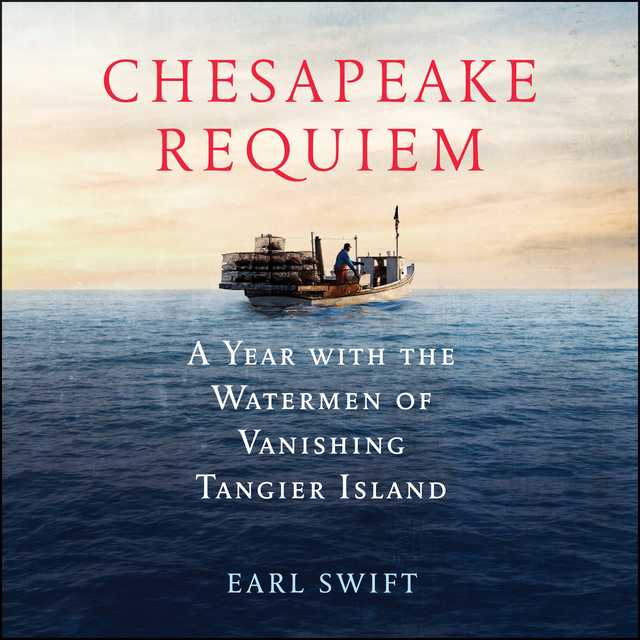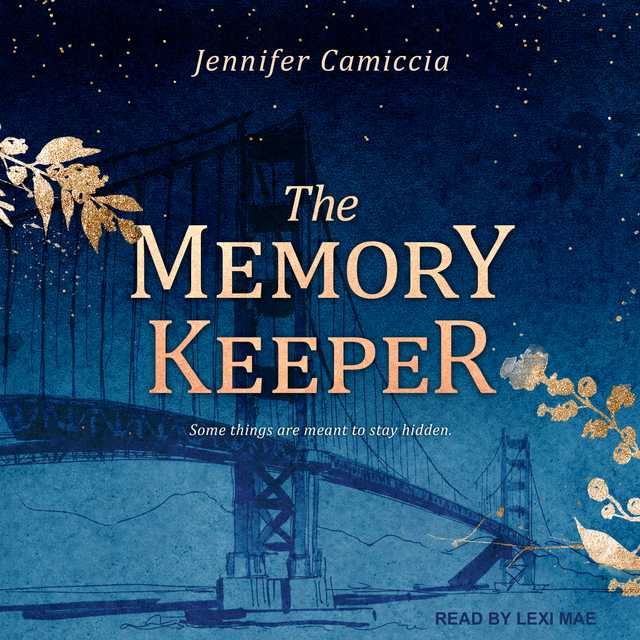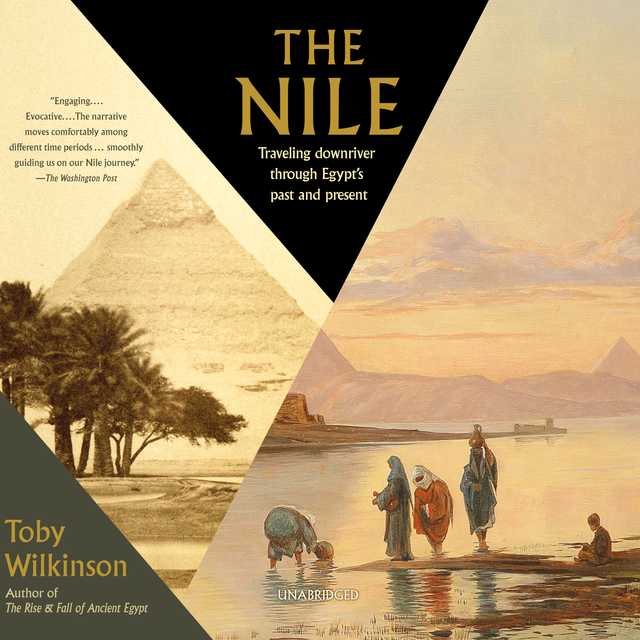Chesapeake Requiem Audiobook Summary
A brilliant, soulful, and timely portrait of a two-hundred-year-old crabbing community in the middle of the Chesapeake Bay as it faces extinction.
A BEST BOOK OF THE YEAR: Washington Post, NPR, Outside, Smithsonian, Popular Science, Bloomberg, Christian Science Monitor, Chicago Review of Books, Science Friday, and Kirkus
“BEAUTIFUL, HAUNTING AND TRUE.” — Hampton Sides * “GORGEOUS. A TRULY REMARKABLE BOOK.” — Beth Macy * “GRIPPING. FANTASTIC.” — Outside * “CAPTIVATING.” — Washington Post * “POWERFUL.” — Bill McKibben * “VIVID. HARROWING AND MOVING.” — Science * “A MASTERFUL NARRATIVE.” — Christian Science Monitor * “THE BEST NONFICTION BOOK OF THE YEAR.” — Stephen L. Carter/Bloomberg
A Washington Post bestseller * An Indie Next List selection *An NPR All Things Considered and Axios “Book Club” pick
Tangier Island, Virginia, is a community unique on the American landscape. Mapped by John Smith in 1608, settled during the American Revolution, the tiny sliver of mud is home to 470 hardy people who live an isolated and challenging existence, with one foot in the 21st century and another in times long passed. They are separated from their countrymen by the nation’s largest estuary, and a twelve-mile boat trip across often tempestuous water–the same water that for generations has made Tangier’s fleet of small fishing boats a chief source for the rightly prized Chesapeake Bay blue crab, and has lent the island its claim to fame as the softshell crab capital of the world.
Yet for all of its long history, and despite its tenacity, Tangier is disappearing. The very water that has long sustained it is erasing the island day by day, wave by wave. It has lost two-thirds of its land since 1850, and still its shoreline retreats by fifteen feet a year–meaning this storied place will likely succumb first among U.S. towns to the effects of climate change. Experts reckon that, barring heroic intervention by the federal government, islanders could be forced to abandon their home within twenty-five years. Meanwhile, the graves of their forebears are being sprung open by encroaching tides, and the conservative and deeply religious Tangiermen ponder the end times.
Chesapeake Requiem is an intimate look at the island’s past, present and tenuous future, by an acclaimed journalist who spent much of the past two years living among Tangier’s people, crabbing and oystering with its watermen, and observing its long traditions and odd ways. What emerges is the poignant tale of a world that has, quite nearly, gone by–and a leading-edge report on the coming fate of countless coastal communities.
Other Top Audiobooks
Chesapeake Requiem Audiobook Narrator
Tom Parks is the narrator of Chesapeake Requiem audiobook that was written by Earl Swift
Journalist Earl Swift has written seven books and hundreds of major features for newspapers and magazines, all distinguished by evocative language and deeply immersive reporting. Since 2012, he has been a fellow of Virginia Humanities at the University of Virginia. Swift has a 26-year-old daughter, Saylor, who is his neighbor in the Blue Ridge mountains west of Charlottesville.
About the Author(s) of Chesapeake Requiem
Earl Swift is the author of Chesapeake Requiem
More From the Same
- Author : Earl Swift
- Auto Biography
- Across the Airless Wilds
- The Big Roads
- Publisher : HarperAudio
- Abraham
- American Gods [TV Tie-In]
- Dead Ringer
- House of Sand and Fog
- Prey
Chesapeake Requiem Full Details
| Narrator | Tom Parks |
| Length | 12 hours 51 minutes |
| Author | Earl Swift |
| Category | |
| Publisher | HarperAudio |
| Release date | August 07, 2018 |
| ISBN | 9780062858245 |
Subjects
The publisher of the Chesapeake Requiem is HarperAudio. includes the following subjects: The BISAC Subject Code is South, South Atlantic (DC, DE, FL, GA, MD, NC, SC, VA, WV), Travel, United States
Additional info
The publisher of the Chesapeake Requiem is HarperAudio. The imprint is HarperAudio. It is supplied by HarperAudio. The ISBN-13 is 9780062858245.
Global Availability
This book is only available in the United States.
Goodreads Reviews
Will
March 25, 2020
All right, USA, who wants to go first? Come on, come on someone, anyone. Let’s see some hands. No? No one? All right then, Mother Nature will just have to choose one of you. Eenie meenie, miney mo, which will be the first to go? All right, Tangier Island, looks like you’re it. Congratulations! You are the premier official global warming refugee site in America. Come on down and receive your prize. Free ferry tickets to the mainland. Don’t let the waves hit you on your way out.Tangier Island - photo credit – Andrew Moore for the NY Times It is a community unlike any in America. Here live people so isolated for so long that they have their own style of speech, a singsong brogue of old words and phrases, twisted vowels, odd rhythms. Its virtually amphibious men follow a calendar set by the Chesapeake Bay blue crab, and they catch more of the prized delicacy than anyone else. It is a near-theocracy of old-school Christians who brook no trade in alcohol, and kept a major movie from filming in their midst over scenes of sex and beer. And not least, this is one big, extended family: All but a few islanders can trace their lineage to a single man.For 240 years they’ve occupied a speck of mud and marsh that nowhere reaches more than five feet above the tide, seldom tops three, and most often fails to clear one. Now it is washing ever faster into a bay on the rise. David Schulte, from the Army Corps of Engineers, on the beach in what’s left of the Tangier region called Uppards – image from the NY Times – photo by Andrew MooreEarl Swift was a reporter for the Virginia Pilot when he got his first briny taste of Tangier island in 1999. He wrote several pieces about this little-known place, that was not only isolated (as isolated as one can be only twelve miles from the mainland), but facing considerable long-term challenges. Tangier had been used by Native Americans for hunting and fishing. It was first mapped in 1608 by one John Smith (you may have heard of him) and not regularly occupied, by Westerners anyway, until 1686, when the Royal Marines built Fort Albion there. It is expected to be claimed by the bay by the mid/late 21st century. It will be rendered uninhabitable long before that. Sparked by a significant item from Scientific Reports in 2015, Swift’s interest was rekindled and he opted to take a closer, deeper look. …little Tangier is important in one respect. As the Scientific Reports article concluded, it’s likely to be the first to go. That experience—and the uncomfortable questions it forces the country to confront—will inform what the rest of us on and near coasts can expect in the decades to come. What makes a community worth saving? Will its size alone prompt the nation to fight for its survival—or are other, less tangible factors as important? Which such factors count the most? And if size is the chief consideration, what’s the cutoff, the minimum population, that’s worth rescue? What, in short, is important to us? And there’s the matter of the Chesapeake Bay blue crab: Without Tangier, big-city restaurants will be serving a lot less softshell, and many more will have to substitute imported crabmeat for the genuine article in their crabcakes. Earl Swift - image from the University of Missouri - Saint LouisFor some the potential demise of Tangier is a crying shame, the loss of a culture that has grown its own ways and language, a real community of real people. Not exactly a lost Stone Age Bornean tribe in their differences from the rest of us, but with enough uniqueness to mark some lines between here and there. For others, the loss of Tangier would be just another manifestation of the ongoing global warming that is raising sea levels and making much of the planet hotter, and much of our weather harsher. The question posed by this book is whether the island is worth saving, given that saving it will entail a considerable public investment. A backyard of a home on Tangier Island gives way to marsh, a trend affecting more and more homes, as erosion, land subsidence and sea level rise afflict the island. Photo taken on Saturday, July 1, 2017 – image and text from The Virginian-Pilot – by Steve EarleyTo inform our answers Earl Swift spent considerable time on the island getting to know its residents, learn the local culture, patois, values, personalities, values, beliefs, and concerns. His more deskbound research offers us both a history of the place and a look at the climatic and geological conditions that seem certain to doom Tangier to a watery grave. The value of the island, and related islands is not just the human history and culture that is at risk. There are natural features that impact the survival not only of local avian life, but the underwater fauna and flora that support a wide range of species, including the blue crab and oyster. There is value to sustaining existing environments and species, for environmental, aesthetic, and commercial reasons. If (when) this island disappears, how will its loss affect the Chesapeake Bay blue crabs that fill so many bellies. How will that loss affect the men and women who bring this renewable resource to our tables. If the potential crab harvest is severely reduced there will be secondary impact, as the shutting down of a significant economic force sends waves through the adjacent economies. What about, for instance, the truckers who deliver crabs and oysters from the Tangier watermen to the rest of the nation, the shops and restaurants that depend on them for customers and product?The Amanda Lee, a typical Tangier workboat – image from OutsideOnLine.com - photo credit Matt EichIn reading Chesapeake Requiem, you will pick up some terminology, will learn to differentiate a jimmy from a sook from a peeler, and appreciate the significance of a sponge on a crab. What might a progger be, or a come-here? What is a doubler, and what are the differences between jumbos, primes, hotels, and mediums, and what is a sugar toad? It is also a place where, when a couple learned that their adopted Asian children had been taken from their birth parents illegally, they gave the kids the chance to meet their biological parents, and choose where to live.Image from The Virginia-PilotIt is a place where an overzealous cop shot a kid for violating a blue law when he was buying his mother milk on a Sunday. It is also a place where someone later shot dead the cop who had been convicted of a crime for that action, but who had been subsequently pardoned. No one will say who. It is a place where being a cop is a considerable challenge when everyone who calls in a complaint is a friend or relative and every one they are calling about is a friend or relative. It is a place where, when a pastor, who was deemed insufficiently conservative, left the Methodist church and started his own parish, he was vandalized by locals. Outside intervention was needed to make the attacks stop. And when the national Methodist Church expressed support for Palestinians wanting their own state, member of the local Methodist church rebelled, creating a schism. From New Yorker article - photo by Gorden CampbellIt is a place where, when one of their most respected captains went down in a stormy sea, fifty boats launched into awful conditions, Dunkirk–like, to try to rescue him. It is also a place where flinty boat owners sometimes skimped on known needed repairs or safety equipment to their own peril, and the endangerment of those seeking to come to their aid.It is a place where a clothing factory that employed mostly women was burned to the ground when the local men were put off by the independence this new employment provided to the island women. It is a place where the vast majority of land-based jobs are held by women, and the vast majority of water-based jobs are held by men.It is a place where plans to build a seawall to protect the island keep getting buried under years of studies, funding denials at federal, state and local levels, and presidential impediments. Wind and waves have ravaged Tangier, including the island’s public beach, shown here – image from The Virginia-Pilot – photo by Steve EearleyIt is a place that welcomes newcomers guardedly, and has benefited mightily from some of the advances those invasive species brought with them. But it is a place that becomes toxic and shunning when those outsiders do not fully accept all the local norms. As individuals, the islanders are fiercely independent and self-sufficient—modern-day cowboys, or so they like to think. As a group, however, they show precious little initiative. It is a place where a man called Ooker knows the local ospreys by name, and feeds them, where feral cats abound, where if you have seen a squirrel on the island, it is really the squirrel, not a squirrel. It is a place where a respect for the land is not always obvious. …objectively speaking, islanders were poor stewards of their island and its waters. The marshes were studded with their discarded kitchen appliances, bicycles. And outboard motors. Litter made eyesores of the ridges. Watermen routinely threw trash, including motor oil, overboard; the harbor’s shallows had acquired a sharp-smelling and colorful sheen. And Tangiermen had nothing but enmity for environmentalists, who warned that the bay’s blue crab population was overfished, teetering on collapse, and would rebound only with tighter regulation of the commercial harvest. Cameron Evans, 17, looks for artifacts from Canaan, one of the communities that once existed on Uppards. This stretch of shoreline, about a 10-minute boat ride from tangier Island’s harbor, has been receding at a rate of 15 feet or more a year recently – image from The Virgina-Pilot – photo by Steve Earley – Friday, June 30, 2017It is a place that has survived an invasion of parasites that almost wiped out the oyster crop entirely, a place where limits on crab takes were routinely ignored, forcing the state to intervene to keep the resource from being wiped out. It is a book that generates few gripes. I recommend that if you are poring through this on or near a digital device, you keep a window open with a map of the islands. It makes it much easier to track where things are while reading. Of course, the full, hardcover edition may offer more visual aids than did the ARE I read for this review, so take that concern with a grain of sea salt. At 380 pps it felt long, but not terribly so. I did feel, though, that at times there might have been too much local culture. That made it feel a bit longer. But not much else. Swift is a gifted writer, with a smooth style, a keen eye for detail, and a very useful ability to get up close with people he started out hardly knowing. An old deadrise workboat sits in a marsh at Tangier island. The island’s three ridges, where people live, are not much more than 4 feet above sea level – image and caption from The Virginia-Pilot – photo by Steve Earley – taken July 1, 2017==========In the summer of 2019 GR reduced the allowable review size by 25%, from 20,000 to 15,000 characters. In order to accommodate the text beyond that I have moved it to the comments section directly below.
Helen
April 05, 2018
An excellent read about our environment, the life on Tangier island, and generally about the Chesapeake. I was born on Chincoteague island, and raised on the Chesapeake in Norfolk, VA. Not enough is written about this unique part of the world, and the people, or at least I can't get enough!I learned a few new things, and after reading, I'd like to be a tourist...particular since it may be gone in my lifetime, or in my children's time. As an environmentalist, I encourage every like-minded readers to read this wonderful account, and realize we can all BeeBetter.info
Jan C
February 22, 2019
I'm from a Maryland family. I think my father may have been the first to leave. As a child I have a memory of my grandfather picking up a dozen or so crabs at the harbor and seeing the crabs crawling all over the kitchen floor. I don't remember if I actually ate any of those crabs. On another night, the adults were passing around a container of fresh oysters. They looked pretty slimy to me. I later learned to like both crabs and oysters, and, oh, those soft-shelled crabs. Of course, now I can't eat any of them as I have developed gout.I think we have always had feelings that Maryland cared more about the Bay than Virginia, and apparently more about saving Smith Island than Virginia does about saving Tangier. I don't know if this means that the residents of Smith were more willing to see the reality of climate change than those of Tangier - they don't believe in climate change. They believe in flooding and erosion but don't believe it has anything to do with rising sea waters. Sounds to me like they're the same thing but the Tangiermen would never believe it. One thing about the Tangiermen is they are quite fundamentalist and seem to take the Bible fairly literally and strong supporters of Trump. Also believe that the Lord will provide, as they continue to watch their island being absorbed by the Bay.The Corps of Engineers has now been studying about what to do about Tangier for the last 20 years. They come up with a theory about a seawall or a jetty and then they have to study it to death. They can't just invest the money and get it done. One of the problems is that it is a three-way partnership - between the federal government, the state and the island - plus, nature has to cooperate and can't be throwing another hurricane or cyclone at the island. I think I read that they had the money set and then Matthew came along - I know Matthew did a job on my new state of North Carolina. But when there's a disaster the money has to go to the disaster.I really enjoyed this book. Swift moved on to the island for a year and got in to their confidence. He went crabbing and oystering with the watermen. It got so I could almost smell the water. My cousins had a place on the Magothy River, one of the tributaries of the Chesapeake. My uncle sailed on the river and possibly on the Bay, they went fishing all the time, my cousin ran trotlines for crabs. I went to one crabfest at another set of cousins - of course, my face did blow up the next day. So I may have been biased toward this book before starting because of my Maryland connections, real and imagined, but I did enjoy it.
Patty
October 15, 2018
”For 240 years they’ve occupied a speck of mud and marsh that nowhere reaches more than five feet above the tide, seldom tops three and most often fails to clear one. Now it is washing ever faster into a bay on the rise. …In fact the lower Chesapeake’s relative sea-level rise – the one-two punch of water coming up and land going down – is among the highest on the Earth, and of all the towns and cities situated on the estuary, none is a vulnerable, none as captive to the effect of climate change, as Tangier.”I don’t know when I first heard about Tangier Island, VA. Probably when I read Beautiful Swimmers: Watermen, Crabs and the Chesapeake Bay by William W. Warner. I found that book when it was first published in 1977 and shared it with my husband and father-in-law. They are the people who first introduced me to crabbing and the delights of picking crabs.Life continued and after a brief foray into the middle of the United States, we have settled happily into Virginia. Since my arrival here, I have learned a lot about Tangier and other places on and in the Chesapeake Bay. I have always loved the shore and the water. Having the Bay within a two-hour drive has a delight.Even though I have been interested in crabs, oceans and Virginia, I have never made the time to visit Tangier Island. It is one of those places I always thought I would get around to – eventually. After reading this book I realize that I can’t wait too long. Mother nature is using Tangier to show us exactly what climate change will do to all of us if we don’t put a stop to it.Swift spent the time necessary to learn about Tangier not only from books and the news, but he stayed on the island and learned firsthand what is going on in that place. His diligence and his way with words shows the residences as they are. He did not fall into the trap of making the people into strawmen for his own agenda.His writing is clear and, in my opinion, unbiased. I am sure there are some folks on the island who would not like his descriptions of them, but that would be true of any report that is not prejudiced towards Tangier. I am grateful to Swift for putting faces on this Chesapeake Bay treasure. I now have a better understanding of these people and their home.I am sorry that most of the residents of Tangier Island are Trump supporters and climate change deniers. I am in the opposite political camp and believe science. Our differences made this book hard for me to read at times. However, the author kept me connected to his story and that helped a great deal.I suspect every politician should be reading this account. Something should be done to save Tangier Island. I worry though that most people would not think this island worth the cost of saving it. It is only a few people and most of us don’t know anyone who lives there. I believe sometimes it is the small things that need rescue the most.
Becky
June 26, 2018
Swift paints a beautiful, poignant picture of Tangier Island, its quickly vanishing shores and its hard-working, close-knit residents, touching on the environmental impact of climate change and the island's historical significance. My only quibble was the lack of a map (would have been a great reference, particularly showing the island's 17th century footprint as compared to today). Some photos of the island's landscape would have also been a nice addition.
Paul
November 20, 2021
Chesapeake Bay’s waters are rising, as are sea levels all over the world, due to climate change. The rising sea levels of Chesapeake Bay threaten the very existence of a number of the bay’s islands – including, notably, the historic and culturally distinctive Tangier Island in Virginia. Since the 17th century, Tangier has been home to a small community of watermen and their families – tough, hard-working people who have made their living through the difficult and often dangerous task of harvesting the Bay’s bounty of crabs and oysters. And journalist Earl Swift dedicated a year of his life to living on Tangier and seeing how the people of contemporary Tangier are responding to these threats – in an engaging 2018 book with a troubling title: Chesapeake Requiem.Swift wrote for many years for Norfolk’s Virginian-Pilot newspaper, the paper of record for the Hampton Roads region of Tidewater Virginia. In the process, he engaged in some thought-provoking examples of participatory journalism. For an earlier book, Journey on the James (2001), Swift and a Virginian-Pilot photographer journeyed by canoe all the way down Virginia’s James River, from its source in the commonwealth’s western mountains to its outlet at Hampton Roads. For Chesapeake Requiem, Swift upped the ante – renting a home on Tangier; living on the island; crabbing and oystering with the watermen; exploring the island’s shrinking shoreline, on foot and by boat, with other Tangier residents; attending community meetings; and spending Sunday mornings at services in one or the other of the island’s two well-attended and fervently supported Methodist churches.Swift had visited Tangier twenty years before, in 1999, to write a Virginian-Pilot story about how the islanders had refused, on religious and moral grounds, to let the Virginia Lottery conduct business on the island. While there, he saw how the island was shrinking as a result of the effects of both erosion and sea-level rise on the island. The island had shrunk much further by 2016, and it was on the basis of those troubling observations that Swift undertook to spend A Year with the Watermen of Vanishing Tangier Island (the book’s subtitle). Over the course of Swift’s year living among the Tangier Island watermen and their families, a number of major themes emerge. One is that the fiercely independent Tangiermen trust in God, take pride in their own ability to wrest a living from the Chesapeake through their hard work, and are generally distrustful of any outside authority. When the watermen gather for regular confabs in an abandoned health-center building that they have dubbed “the Situation Room,” problems with secular authority are a regular topic of conversation. A waterman named Leon complains that the Virginia Marine Resources Commission (VMRC) has taken away a Tangierman’s crabbing license for the rest of the year, for an undisclosed third violation of state laws. “What’s he going to do? They’ve taken away his living!...There’s something wrong with that part of the law. What am I going to do if I can’t work on the water?...I ain’t got a Colonel Sanders fried chicken place I can go to for a job” (pp. 105-06). Swift, who also understands the perspective of organizations like VMRC that are trying to preserve the overall crab population of the bay, sees complaints like these as emblematic of “Tangier’s long, fractious history with officials and officialdom” (p. 107).Because of the sheer amount of time Swift spent living on Tangier, he is able to delve below the popular image of life on the island. For instance, he looks at the island’s established reputation for religiosity, and points out that, while the people of Tangier Island are indeed devout, they have also shown the potential for taking the law into their own hands, sometimes violently: “Piety and lawlessness [are] competing facets of the Tangier character” (p. 203). In support of that claim, Swift cites examples of unsolved murder and arson cases from Tangier’s past, and then moves to a crime that took place while he was living on the island, and that shook residents of Tangier to their core – the theft of $3,000 worth of funds from Swain Methodist Church. One parishioner says of the theft that “It’s the worst thing that’s ever happened on Tangier” (p. 205), and her dramatic declaration causes Swift to reflect:It strikes me as an overstatement, what with the cholera, the deaths of islanders in boats and in combat, and myriad other tragedies that have befallen the place over the past two centuries. But then, I reflect, the church has always been the rock on which the island depended in hard times. The church…has been a refuge against all the uncertainties of life on a tiny island isolated and buffeted by big water. Church has been central to the essence of Tangier, and Tangier central to church. Perhaps erosion threatens both. (p. 205)The Tangiermen that Swift spends that year with are, by and large, skeptical about climate change. They acknowledge that erosion is nibbling away at the island; but to accept that anthropogenic climate change could threaten the island’s existence seems for many to offend their sense of God’s providence, their abiding belief that “the Lord will provide.”When efforts at promoting positive change in Tangier residents’ attitudes toward the environment have worked, it seems to have been when the islanders’ religious devotion is respected and taken into account as part of the equation. At a time of confrontation between the islanders and the Chesapeake Bay Foundation environmental organization, a doctoral student working with the CBF encouraged the watermen to reflect “that the bay was God’s creation and its stewardship a Christian duty” (p. 299). Her efforts “fostered dialogue among islanders, regulators, and the CBF that made plain to all that they’d been talking past one another” (p. 300). Years after that doctoral student sought to establish that dialogue, Swift remarks, “Tangier is far cleaner and tidier today than when I first visited” (p. 301).Yet such encouraging anecdotes must be balanced against the overwhelming evidence that the island continues to shrink. One time after another, Swift is taken on a boat trip around the island, and his informants, Tangier natives all, show him where areas that used to be centers of settlement or thriving stands of coastal forest are now well under the water. Inundated cemeteries give up their dead. Seagrasses that provide shelter for blue crabs recede, and the watermen’s harvest of “peelers” (soft-shell crabs) becomes less predictable.Over the course of Chesapeake Requiem, the reader gets a strong sense of Swift’s affection and respect for the people of Tangier Island. He may not agree with all of their perspectives (for instance, their 87% support for Donald Trump in the 2016 presidential election), but he is impressed by the way they look out for one another – something that is demonstrated when a father-and-son team of watermen run into serious trouble one stormy day on the Bay. Swift concludes Chesapeake Requiem by expressing his hopes that some kind of intervention can save the island from inundation; but the very title of his book speaks to his concern that any such attempts at saving the island may be too little, too late.
S
August 27, 2019
This was written for me. Having lived on Virginia's Eastern Shore, as well as some of the other areas mentioned in the book, there was near constant nostalgia on every page. I've worked in seafood restaurants that served the very crabs and oysters discussed in the book. As a boy scout I camped on once inhabited barrier islands on the other side of the Eastern Shore. We got there in a boat very similar to the ones described in the book. I'm also United Methodist. While I don't agree with the extremely conservative theology adhered to on Tangier, the religious history of the island was fascinating.Swift does a great job of capturing the personalities and stories of the island characters. He weaves personal tragedy and joy with ecology, geology, religion and politics. His love of both the people and the island itself come through.Highly Recommended.
Hilary "Fox"
September 18, 2018
What criteria do we use to determine who we save when the sea-level rises? Will we only save cities of a certain population size - and if so, what number is the cut off? Will it be determined by historical importance? By environmental importance? How will we decide?One thing seems certain... by the time we do decide, it will be too late for Tangier Island.Tangier Island is among the last holdouts of the great watermen of the Chesapeake Bay. There, the tiny population gets the Chesapeake Bay Blue Crab, so cherished by Marylanders and Virginian. They get enough that they provide over 95% of the crab to local businesses, as well as NYC. If you aren't close to the Bay, you aren't getting the real deal. Even though many restaurants claim to carry it. They also provide the bulk of the oysters to the area. If they go, the crab go, as does a tradition that stretches back plain to the 1600s. The isolated islanders are a fascinating people, and one not nearly so well documented as they should be. Their voices haven't been heard, and even Earl Swift had to work rather hard to explain why. Their fate is the fate of many poverty-ridden areas, yet even that is exacerbated by the problems of erosion and climate change. With an island that is fast disappearing, why should the younger generations stay? The population is aging, too many moving, too few opportunities. Part of the die-off is due to the above, part due to how difficult and isolated it is. Yet everyone who goes there, loves it, and feels a strong attachment to it.Tangier's future is in the balance, and there is not much hope for it. This book is indeed a requiem, a requiem for a way of life eroding as quickly as the island is. A requiem for what will be lost if it goes, and what already is gone. It's a strange, beautiful, and haunting story. Anyone familiar with the region should definitely familiarize themselves with it. Internalize it. It soon may be too late to do anything other than that.
Bob
April 01, 2019
Summary: A journalist's account of nearly two years on Tangier island, the tight knit community organized around watermen harvesting blue crabs, and the likelihood that it may disappear within the next century.I first learned about Tangier Island nearly twenty years ago when I heard one of the people mentioned in this book, Susan Drake Emmerich, speak about the Watermen's Covenant she helped facilitate, rooted in the strong Bible-based beliefs of the island's watermen, that helped ease tensions over state and federal laws and fostered care for the island environment as well as the crabs and the Chesapeake Bay that provided their livelihood.Earl Swift chronicles a different threat to the very existence of the island. Throughout the Chesapeake, there are shoals that were once inhabited islands. Over the last two centuries, Tangier Island has lost two-thirds of its land. The northern part of the island, called Uppards, once was inhabited. Now its graves are washing into the sea and most of it is a patchwork of marsh and open water. The west end of the island's shipping channel has widened to over 75 feet. A seawall protects the landing strip on the south end of the island. Residents are hoping for a jetty off of the shipping channel, and a sea wall around the island. The cost is over $30 million, and most consider that it would be cheaper to relocate this community of under 500 to the mainland. The most obvious cause is coastal erosion, evident after every major storm when more coast is lost and parts of the island are inundated. However, geologically, Tangier is slowly sinking, and the Chesapeake is slowly rising. It's possible that all or most of it could be submerged within 50 years.Swift, who first visited a much bigger island in 2000, returned in 2015 and spent the best part of two years researching his account of the island. It is not only an account of what is happening to the island, but an account of the community that traces its origins back to 1608 when John Smith mapped it and the Revolutionary War, when it was settled. Many of the current residents trace their lineage back to these early settlers and most are related.Swift joins in every part of the island's life from sessions of the island's elders at "The Situation Room" to attending both of the island's churches. He eats at the restaurants, endures the insects, and attends the funerals. He describes town services from the sewage plant to the local grocery, the school, and the visitor center (a place representing a painful memory). Most of all, he spends time with the watermen on their boats, especially James "Ooker" Eskridge, mayor of Tangier and the town's spokesperson when the media come calling. Up before dawn, we get a sense of how hard the work of crabbing is, and how precarious this existence always has been, even before declining catches.Perhaps the most riveting part of the account is that of Ed "Eddie Jacks" Charnock and his son Jason, who are stranded on a sinking boat during a blinding, gale force storm on the bay, and the urgent rescue efforts mounted by the other islanders who hear the one distress message they were able to send out. It is a story that represents the tightly knit character of this community as well as the deep biblical faith that undergirds their life.Perhaps the most striking thing about Swift is his ability to portray the islanders on their own terms. There is no deprecation of their religious faith or their avid support of President Trump and denial of climate change (islanders attribute all the loss of land to erosion and dismiss evidence of island subsidence and water level rise.) He even affirms that Ooker Eskridge bests Al Gore in a discussion with his straightforward assertions that he has seen no water level changes at his crab shack.At the same time, he describes an island that is slowly dying, no matter what the islanders believe. Youth are moving to the mainland, and the elders are dying and the population continues to decline. Properties are abandoned, and despite the religious rectitude, there is evidence of drug use among a portion of the population. There are tipping points approaching for sustaining everything from the local school to the grocery.Swift calls his book a requiem. While Tangier has not yet died and its residents have not given up, the book helps us to appreciate on a small scale what it would mean to this beautiful place and its tight knit, beautiful, and productive community, to be lost. He helps us care for these people and their place. I find myself also thinking that this might be the first of many requiems, or perhaps a more hopeful image is that Tangier is the canary in the coal mine, a warning of how much more we might lose if we fail to act. The factors that endanger Tangier are the same ones that put our naval station at Norfolk at risk, and even our nation's capitol, as well as the coastal cities of the world. Perhaps the irony that the islanders themselves dismiss climate change and its effects is also salutary. It is one thing to have to relocate under 500 climate refugees. Potentially this could be multiplied by millions in the years ahead. Will we close our ears to this requiem until catastrophe is upon us, or take prudent steps now? If the trends at Tangier are any indication, we may know the answer within a generation.
Maureen
June 05, 2019
journalist Earl Swift spent a over a year visiting and living on Tangier Island in the Chesapeake Bay. Chesapeake Requiem tells about past and present life on the island and introduces to the hardworking individuals that live there. Due to subsidence and rising sea levels the island has been shrinking since the nineteenth century, but has been losing even more land to the Chesapeake this century. Islanders who have mostly made their livelihoods crabbing and harvesting oysters will sadly likely lose their home in about 25 years or less. Tangier's story is or will likely be the story of many islands and coastal communities around the world if sea levels continue to rise as they do now. This book is an interesting look at a disappearing, unique island and its way of life, and makes us think about the coming loss and chaos as people are forced to leave communities because of rising oceans.
Al
March 29, 2021
Hot damn, Oral! Suchimpressive journalism. And true to Tangier!
John
August 27, 2021
While I had never heard of Tangier Island, Virginia before reading this book, I very much enjoyed finding out about the island and its 400+ inhabitants from Earl Swift who spent more than a year getting to know them. The island, located in the center of Chesapeake Bay, is slowly being eaten away and may not be around to see another century. I liked the evenhanded way that Earl Swift told their story. While he himself believes in climate change, is fairly irreligious and liberal, he allows us to hear the voices of the inhabitants who are very religious and conservative and do not believe that they are losing their island to the changing climate. He tells their story in a very empathetic way but also shares his own research and opinion on the issues that confront them. He formed deep friendships and left the island very fond of the residents of the island. Most make their livings catching crabs and oysters and this part of their lives is brought out very well. I am glad that Earl Swift allowed me to get to know these people, their island and their way of life fully.
Colin
April 08, 2021
This book does a lot of different things, which, combined with the island references and crabbing terminology, can make it hard to follow. But in sum it offers a holistic view of the island, its culture and community, and what stands to be lost as it sinks into the Bay. The book mostly takes the forms of little vignettes from the author's time on the island, with details taking him tangents explaining variously the island's history, the science behind its erosion and sinking, the finer points of the crabbing industry and other fisheries, and the people and culture of the island. I think in many ways this book is what Hillbilly Elegy tried to be, as it offers a frank portrait of a way of life that seems to be incompatible with the changes approaching the modern world, but with more sympathy for the people and less blaming of them for the larger, societal problems that affect them. Swift makes it easier to understand how a community so threatened by climate change could overwhelmingly support someone who called climate change a hoax, as they saw him as someone who could finally cut through the red tape that has held up so many projects intended to save their island. All in all, I really enjoyed the book and Swift's background as a journalist definitely helps give the island a vivid description, so I'd definitely recommend this for anyone interested in reading about the community who will likely become America's first modern climate refugees.
Sandi
June 21, 2022
The residents of Tangier Island off the eastern shore of Virginia have the dubious distinction of being likely the first climate change refugees in the United States. For two hundred years, hard working people have made a living off the water, fishing for crabs and oysters. Because it’s so remote, their culture, language and beliefs have evolved or failed to evolve with the rest of the nation, and certainly with the rest of the world. The people’s unique traits have both helped them survive and hindered them from adapting to change. This nonfiction journal of life on Tangier Island over a year’s time became very interesting once it turned more to sociological observations and a little less about the business of crabbing. I now know more about crabbing than I ever really wanted to know. The problem with staying on an island for so many generations is that it encourages passivity and resistance to help from outsiders. When there are only a few hundred of you and you’re all somewhat related, everyone else is an outsider. And when facing a danger as serious as climate change, you need outside help. Oh, and by the way, you need to believe in climate change. So, is this place special enough for us to spend millions of dollars to try and save it? Whatever we do will set a precedent for how we respond to all the other coastal communities that are going to be threatened. It’s time for us to be thinking about this.
Shruts
August 29, 2019
4.5* actually. I'll tell why later.This is a sad and somber book. Swift chronicles the death of not only one of the islands elders, but also a way of life, a community, and what was once a thriving commercial enterprise.Tangier Island has a history reaching back centuries, over which the inhabitants by and large subsisted on the bounty of the Chesapeake Bay: crabs, oysters, and varieties of fish to numerous to name. In one astounding revelation, after the railroad reached the adjacent mainland after the Civil War, Tangier literally looted the bay's oyster beds and shipped millions of bushels to NYC in only one winter!It's all collapsing, literally, under their feet. The island will be gone in a generation, giving in to the inexorable sinking of the Mid-Atlantic shelf, rising tides from global warming, and increasingly potent storms from climate change washing away their shores. Their children go to college on the mainland, and come back only for Thanksgiving and ChristmasCompound that with the fickle behavior of their life support, the fisheries, which seem to be also suffering from the erratic bay temperatures and storm disruption, but also development on the adjacent mainland shores which impede the environment.The watermen themselves seem to be unanimous in their denial of global warming and climate change. I'll leave the politics aside, then, other than to comment that their belief that our current president will build them a protective "wall" around their own island is, well, DOA.I salute the author. He spent weeks every month for over a year, living among the residents doing research, working the boats, gaining their confidence, making friends, and at the end of the day respecting them 100%Why not 5*? Too many genealogical diversions. My head spins still about the infinite family interconnections on an island where there are still basically only 3 or 4 family names after 300 years
Peter
March 12, 2022
Excellent in almost every way. I won't eat a crab cake sandwich again without thinking on the difficulties and hardship someone endured to produce it. Journalists who embed in a culture and write about it provide insights that are hard to come by (think of Matthew Desmond in 'Eviction') but are crucial to getting outside our own little orbits and seeing things from other viewpoints. Earl Swift's reporting and writing in this book is generally objective although his own biases are evident, but how could they not be? It is a book, not a news article. He is generally respectful of the very different populace within which he was embedded for over a year. But also clear-eyed about the severe challenges facing the island in a way that the locals struggle with. I learned a whole lot about Tangier Island--it's history, unique people, religion, crabbing, oystering and always the relentless erosion that threatens the existence of the entire place. A lot of critics have emerged apparently, concerned that the island residents 'accept' the reality of global warming and sea level rise. But how many of 'us' embrace life-style changes that might make any difference? Very, very few indeed. Much of the animus toward the islanders apparently emerged in 2016 when they dared to support Donald Trump and stated so. That of course was not 'acceptable'!
Patrick
October 08, 2018
An interesting account of year in the life of the fishermen of the Tangiers Islands. The fishermen are hardworking and brave. Theirs is a vanishing way of life on a vanishing island. The island is a virtual theocracy, patriarchy and is deeply conservative. Despite deep faith, 87% voted for the presidential candidate known for sexual abuse of women, adultery, divorce. and divisiveness. Apparently the other candidates support of gay rights trumped these flaws. Climate change in the face of rising sees is doubted. Erosion eating away at their island is not. The conservatism of the Islanders extend beyond politics: any significant change on the island has been driven by newcomers known as"come heres". Come heres were responsible for the electrification, medical facilities, plumbing and municipal beautification of the island. Inertia seems to always reign. But so does bravery and hard work. An intriguing look at life from the seas.
Frequently asked questions
Listening to audiobooks not only easy, it is also very convenient. You can listen to audiobooks on almost every device. From your laptop to your smart phone or even a smart speaker like Apple HomePod or even Alexa. Here’s how you can get started listening to audiobooks.
- 1. Download your favorite audiobook app such as Speechify.
- 2. Sign up for an account.
- 3. Browse the library for the best audiobooks and select the first one for free
- 4. Download the audiobook file to your device
- 5. Open the Speechify audiobook app and select the audiobook you want to listen to.
- 6. Adjust the playback speed and other settings to your preference.
- 7. Press play and enjoy!
While you can listen to the bestsellers on almost any device, and preferences may vary, generally smart phones are offer the most convenience factor. You could be working out, grocery shopping, or even watching your dog in the dog park on a Saturday morning.
However, most audiobook apps work across multiple devices so you can pick up that riveting new Stephen King book you started at the dog park, back on your laptop when you get back home.
Speechify is one of the best apps for audiobooks. The pricing structure is the most competitive in the market and the app is easy to use. It features the best sellers and award winning authors. Listen to your favorite books or discover new ones and listen to real voice actors read to you. Getting started is easy, the first book is free.
Research showcasing the brain health benefits of reading on a regular basis is wide-ranging and undeniable. However, research comparing the benefits of reading vs listening is much more sparse. According to professor of psychology and author Dr. Kristen Willeumier, though, there is good reason to believe that the reading experience provided by audiobooks offers many of the same brain benefits as reading a physical book.
Audiobooks are recordings of books that are read aloud by a professional voice actor. The recordings are typically available for purchase and download in digital formats such as MP3, WMA, or AAC. They can also be streamed from online services like Speechify, Audible, AppleBooks, or Spotify.
You simply download the app onto your smart phone, create your account, and in Speechify, you can choose your first book, from our vast library of best-sellers and classics, to read for free.
Audiobooks, like real books can add up over time. Here’s where you can listen to audiobooks for free. Speechify let’s you read your first best seller for free. Apart from that, we have a vast selection of free audiobooks that you can enjoy. Get the same rich experience no matter if the book was free or not.
It depends. Yes, there are free audiobooks and paid audiobooks. Speechify offers a blend of both!
It varies. The easiest way depends on a few things. The app and service you use, which device, and platform. Speechify is the easiest way to listen to audiobooks. Downloading the app is quick. It is not a large app and does not eat up space on your iPhone or Android device.
Listening to audiobooks on your smart phone, with Speechify, is the easiest way to listen to audiobooks.






























